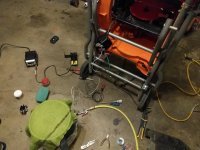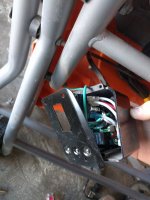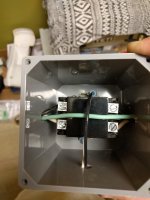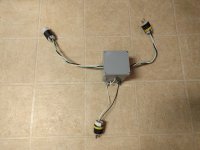You are using an out of date browser. It may not display this or other websites correctly.
You should upgrade or use an alternative browser.
You should upgrade or use an alternative browser.
What can I connect to CT36 AC?
- Thread starter Lazy
- Start date
Bohdan
Member
Its not about extending the life of your current filter. The CT36AC standard filter is not designed for wood dust. It will pass the invisible fine dust that is the most harmful to your health and the bag is to protect the HEPA filter that you should be using.
Thanks for the info.
While I'm thinking about it I feel I must make a small but important statement about safety before I start posting pictures of electrical circuits that could potentially harm readers. I am not an electrician. However, I am a registered professional engineer and have been trained to have a decent knowledge of electrical theory and circuits which helps me reason through questions that arise when I'm throwing some solution together that works for me. This helps to keep me from killing myself. Please be very çareful and if you don't completely understand what you are doing, please let an electrician do it for you.
Ok, disclaimer done and I will get more information and pictures as soon as I get a chance.
While I'm thinking about it I feel I must make a small but important statement about safety before I start posting pictures of electrical circuits that could potentially harm readers. I am not an electrician. However, I am a registered professional engineer and have been trained to have a decent knowledge of electrical theory and circuits which helps me reason through questions that arise when I'm throwing some solution together that works for me. This helps to keep me from killing myself. Please be very çareful and if you don't completely understand what you are doing, please let an electrician do it for you.
Ok, disclaimer done and I will get more information and pictures as soon as I get a chance.
AlexThePalex
Member
- Joined
- Nov 12, 2008
- Messages
- 7,757
Bohdan said:Its not about extending the life of your current filter. The CT36AC standard filter is not designed for wood dust. It will pass the invisible fine dust that is the most harmful to your health and the bag is to protect the HEPA filter that you should be using.
I don't think this is correct, the filter is designed to filter down to a specific size of particles, not a specific type.
If you look at Festool websites, the standard filters that come with the CT26/36 and CT36AC vacs all have the same rating.
Only the American HEPA standard has a better filtration, so from that viewpoint using a standard filter is a downgrade, but it is still sufficient to filter the harmful particles, whether it's wood or any other type of dust.
I Europe it is possible to get a CTL 36 AC HD vac which is an autoclean vac specifically designed for wood dust, according to Festool, and it comes with the same filter as the standard CTL 36 AC.
Bohdan
Member
The filter that is supplied as standard with the CT36AC is rated to remove up to 1 micron whereas the HEPA filters go down to 0.3 micron. Unfortunately the most harmful particles are the invisible ones whose size is between 1 and 0.5 microns.
I find it strange that in Australia and NA the extractors are supplied with HEPA filters as standard but in Europe they only filter down to 1 micron, defined as L class which actually excludes wood dust.
The CT36AC HD is designated for wood dust as it has an M class filter.
I find it strange that in Australia and NA the extractors are supplied with HEPA filters as standard but in Europe they only filter down to 1 micron, defined as L class which actually excludes wood dust.
The CT36AC HD is designated for wood dust as it has an M class filter.
I sent this question to festool:
"What is the maximum wattage that the outlet on the front of my dust extractor can handle. I see that it has a plate that says the outlet can handle 3.7 amps when suction is high and 9.1 amps when suction is turned down to low setting.
The kapex is listed at 13amps or 1600 Watts. Does this mean you don't recommend pluging the kapex into the dust extractor?"
Here is the answer:
"Thank you for contacting Festool. All of Festool's Dust Extractors are intended to work with all of Festool tools. The Kapex saw will not draw full amps when in normal use, so it will work just fine with the CT Dust Extractor. The only time that you might experience low power would be when the CT Dust Extractor is under full load (max power and bag completely full) and when the Kapex saw is pushed to its limits. At that time you might have to plug in he Kapex Saw directly to a power source. Under normal operation of the CT and Kapex they will work perfectly fine together."
This is the answer we all expected and the reason I didn't ask sooner but I figured I would add it to the thread for posterity.
"What is the maximum wattage that the outlet on the front of my dust extractor can handle. I see that it has a plate that says the outlet can handle 3.7 amps when suction is high and 9.1 amps when suction is turned down to low setting.
The kapex is listed at 13amps or 1600 Watts. Does this mean you don't recommend pluging the kapex into the dust extractor?"
Here is the answer:
"Thank you for contacting Festool. All of Festool's Dust Extractors are intended to work with all of Festool tools. The Kapex saw will not draw full amps when in normal use, so it will work just fine with the CT Dust Extractor. The only time that you might experience low power would be when the CT Dust Extractor is under full load (max power and bag completely full) and when the Kapex saw is pushed to its limits. At that time you might have to plug in he Kapex Saw directly to a power source. Under normal operation of the CT and Kapex they will work perfectly fine together."
This is the answer we all expected and the reason I didn't ask sooner but I figured I would add it to the thread for posterity.
At the request of Bohdan I tested with the hoses I have. I still don't have a bag in.
Blast gate open with planex hose:
10.8 amps continuous
12 amps at start
Blast gate open with 27mm 3.5m AS hose:
9.8 amps continuous
11.5 amps at start
The small hose obviously decreases the air pressure around the fan which decreases the air density and allows the motor to spin up to target rpm using less power. Not a huge change but noticeable. It's actually more complicated than that and probably has something to do with reduced shear force and angular momentum because of the reduction of air flow.
Blast gate open with planex hose:
10.8 amps continuous
12 amps at start
Blast gate open with 27mm 3.5m AS hose:
9.8 amps continuous
11.5 amps at start
The small hose obviously decreases the air pressure around the fan which decreases the air density and allows the motor to spin up to target rpm using less power. Not a huge change but noticeable. It's actually more complicated than that and probably has something to do with reduced shear force and angular momentum because of the reduction of air flow.
Holmz, The contactor I used as an automatic switch is the Packard C230B 2 Pole 30 Amp Contactor. I paid about $10 from Amazon. Note that the 30amps is the max rating to put through the contactor. The coil probably doesn't pull much power at all to operate. I'll test it when I take pictures of the assembly.
Here's a picture of the mess I made when I tapped into the table saw. You can use T-taps to splice into the lines but I was worried about vibration and corrosion so I soldered directly onto the existing contacts and was able to squeeze into the existing insulator jacket making shrink tubing unnecessary.

Here's a picture of the mess I made when I tapped into the table saw. You can use T-taps to splice into the lines but I was worried about vibration and corrosion so I soldered directly onto the existing contacts and was able to squeeze into the existing insulator jacket making shrink tubing unnecessary.
Attachments
AlexThePalex
Member
- Joined
- Nov 12, 2008
- Messages
- 7,757
Bohdan said:The filter that is supplied as standard with the CT36AC is rated to remove up to 1 micron whereas the HEPA filters go down to 0.3 micron. Unfortunately the most harmful particles are the invisible ones whose size is between 1 and 0.5 microns.
I find it strange that in Australia and NA the extractors are supplied with HEPA filters as standard but in Europe they only filter down to 1 micron, defined as L class which actually excludes wood dust.
The CT36AC HD is designated for wood dust as it has an M class filter.
L and M filters are the same. CT 36 AC HD is in both L and M version available, only difference is the alarm that sounds when suction drops.
Though European L and M classes are not as rigorous as HEPA, they still suffice. It is not like the European commission with its overregulation is going to take any chances.
Bohdan
Member
The L and M filter differences are not the same as the Festool L & M vac differences. The L (#496170) and M (#496172) filters have different filtration standards with the M filter 10 times more rigorous than the L.
It is interesting that the in NA Festool L & M vacs are promoted as only having the alarm function as the difference. That is because they are supplied with HEPA filters (#498994). In the EU you also have to change the filter to be an M class machine.
It is interesting that the in NA Festool L & M vacs are promoted as only having the alarm function as the difference. That is because they are supplied with HEPA filters (#498994). In the EU you also have to change the filter to be an M class machine.
AlexThePalex
Member
- Joined
- Nov 12, 2008
- Messages
- 7,757
Bohdan said:The L and M filter differences are not the same as the Festool L & M vac differences. The L (#496170) and M (#496172) filters have different filtration standards with the M filter 10 times more rigorous than the L.
It is interesting that the in NA Festool L & M vacs are promoted as only having the alarm function as the difference. That is because they are supplied with HEPA filters (#498994). In the EU you also have to change the filter to be an M class machine.
Bohdan, absolutely NOTHING of what you say above is correct. Please check your sources.
1 - With NA, do you mean North America? America does not have L and M classes at all. That's why in America all vac names start with CT only while in Europe the vac names start with CTL or CTM. L and M class is a EU only classification.
2 - L and M filters are EXACTLY the same. Go check the Festool websites in Europe and see which filters they list as compatible under the different catagories. They're the same. It is not like I'm making this up, the info is there to see for everyone.
3 - Filters 496170 and 496172 are not different numbers for L and M filters. The first is the standard filter used for all non AC vacs. The second is what they call the "High Performance" filter for the AC vacs, where high performance does not mean better filtration, but more ruggedness to be able to withstand the forces that an AC vac puts on the filter when it cleans it by shaking it.
4 - In the EU you do not have to change the filter to turn a L vac into an M vac, because the filters are exactly the same. As I said before, the ONLY difference between an L and an M vac is the suction alarm of the M class. Supposedly this leads to the 10x better filtration than the L class, which, if you think about it, is a BS claim.
Holmz
Member
- Joined
- Oct 11, 2014
- Messages
- 3,876
Lazy said:I forgot to measure the coil power as I said I would so I opened the box one more time to satisfy my curiosity.
From direct measurement:
0.074 amps
123.3 volts
Thanks Mate - I found a 240v version on Amazon, although I am not sure it matters much.
Since I need a 110v tool on a transformer to trigger a 230v vacuum, or some odd combo, I think I will make one.
I'll give you an example of confusion....
My dad is a smart guy but when I told him I wired a 2-pole contactor to run my shop vac simultaneously with my table saw on two separate 20A breakers, the first thing he said was, "I thought 2-pole contactors were for 240v".
I said, "yes they are if you run one 120v leg through each pole".
So the best method in my opinion is to check to make sure you are supplying the correct voltage to the coil so it doesn't try to pull more or less amps than it should, and make sure you don't exceed the specified amperage over each pole. We are trying to make a connection.... Not a camera flash.
I hope this is helpful.
My dad is a smart guy but when I told him I wired a 2-pole contactor to run my shop vac simultaneously with my table saw on two separate 20A breakers, the first thing he said was, "I thought 2-pole contactors were for 240v".
I said, "yes they are if you run one 120v leg through each pole".
So the best method in my opinion is to check to make sure you are supplying the correct voltage to the coil so it doesn't try to pull more or less amps than it should, and make sure you don't exceed the specified amperage over each pole. We are trying to make a connection.... Not a camera flash.
I hope this is helpful.
Similar threads
- Replies
- 24
- Views
- 5K
- Replies
- 2
- Views
- 131K
- Replies
- 4
- Views
- 3K
- Replies
- 20
- Views
- 2K




